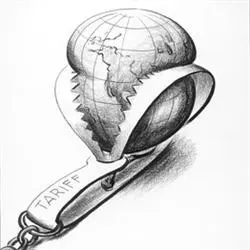Understanding Tariffs and the Economic Landscape: A Modern Perspective

In recent discussions about tariffs and trade, there’s a significant disconnect between what is proposed and what economic history teaches us. This is particularly evident in the context of past beliefs that shaped modern economic policies, especially during the Trump administration. At Extreme Investor Network, we delve deep into these nuances, shedding light on how history should inform our economic strategies today.
The Misguided Fiscal Lens of the Past
Former President Trump’s approach to tariffs has been criticized for harkening back to a medieval understanding of economics, one that seems oblivious to modern principles. I aim to unpack these ideas not from a place of bias but from a historical and economic analysis that respects all perspectives.
Historically, the notion surrounding currency and its backing has evolved. Currencies, including today’s dollar, are largely fiat. This means they derive their value not from intrinsic worth but rather from public trust and government decree—a concept established long ago in regions like Lydia, where coinage originated. Debasement during financial strife—most notably during wars or economic downturns—demonstrates how history often repeats itself, and yet certain lessons remain unlearned.
The Evolution of Currency and Power Dynamics
Ancient Lessons from Greece and Rome
The narrative of economic supremacy in history often shifts with power dynamics. After the fall of Persia, Athens took the reins, only to be stretched thin during the Peloponnesian War, resulting in desperate monetary policies. Sound familiar? In 404 BC, Athens had to issue emergency coinage, ultimately echoing the struggles seen in modern economies when currency is manipulated under duress.
Following the dramatic transformation of Japan and Germany post-World War II, we’ve witnessed how productivity—not just resources—fuels economic ascendance. Today, Russia stands as a testament to this idea: a country rich in resources yet hindered by past ideological constraints which led to suppressed productivity.
The Dollar’s Reserve Status: More Than Meets the Eye
The dollar’s status as a reserve currency is frequently misconstrued. Most believe that its backing is solely tied to gold or silver. However, like the ancient Romans who thrived on trade (even establishing a vibrant economy through intercontinental exchanges), the U.S. strength lies in its people’s productivity and innovation. This was famously illustrated in Nixon’s Kitchen Debate, showcasing American ingenuity in contrast to its contemporaries.
As the global landscape shifts, often due to geopolitical machinations (such as the pushback against BRICS nations), we see an awakening of nations seeking alternatives to dollar dependency—an echo of historical circumstances where power dynamics demanded adaptability. The current tussle over economic influence is reminiscent of past centuries, where countries forged new paths in response to their economic needs.
Understanding Tariffs: Implications for America’s Future
While Trump’s administration viewed tariffs as a mechanism to restore America’s economic prowess, the implications could be dire. Introducing 25% tariffs, aimed at coaxing manufacturers to pivot back to American shores, risks pushing global trade dynamics into disarray. History informs us that isolationist policies often reverberate as retaliation rather than resolution.
The reality is that American competitiveness isn’t solely based on manufacturing proximity. Rather, it thrives on a complex web of global trade where each partner’s economy plays a balancing role. Companies left the U.S. for various reasons—including unique taxation structures that added undue burdens to global competitiveness.
In essence, the attempt to bring back manufacturing without addressing underlying fiscal strategies and global trade philosophies might just be paving a road to stagnation rather than revitalization.

A Glimpse into the Future
As we look ahead to potential turmoil by 2032, driven by economic isolationism, we must engage in serious reflection about the policies being enacted today. The dire forecasts from our own computers are clear: Recession is on the horizon, and without innovative, adaptive policies, unemployment is not poised to decline.
Conclusion: Reassessing Economic Strategies
At Extreme Investor Network, we believe that understanding historical precedents can guide future economic strategies. Tariffs, trade, and currency manipulation are complex issues best approached with a mind open to the lessons of history. Embracing innovative, productive policies rather than falling back on past ideologies will determine whether we can navigate the challenging waters of the global economy.
The dialogue surrounding these topics is critical, and we encourage readers to explore these dynamics further. Be sure to stay connected for updates and insights that matter—a path to informed investment strategies. Your economic future is intrinsically tied to understanding past lessons, and we’re here to help you grasp their relevance today.

